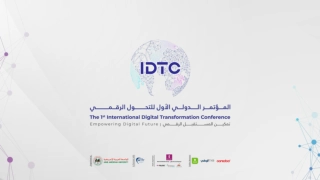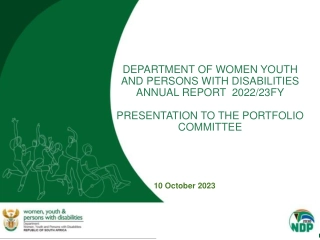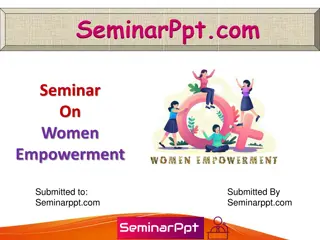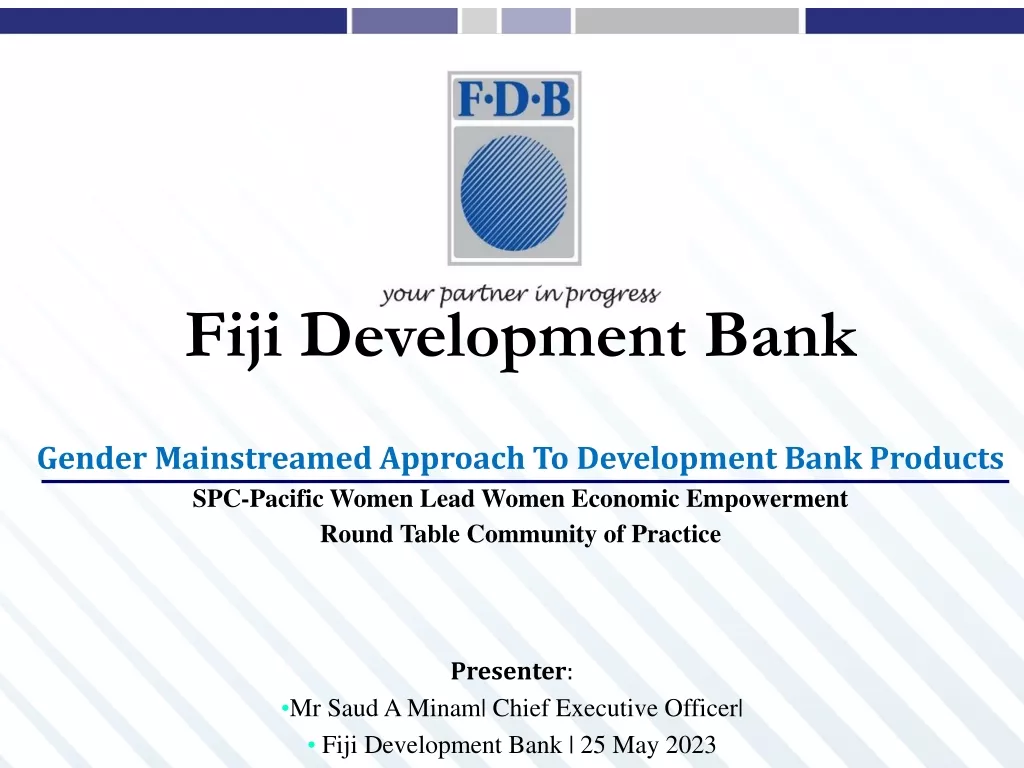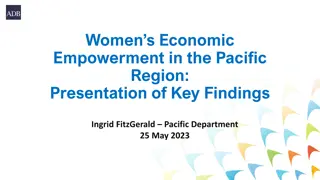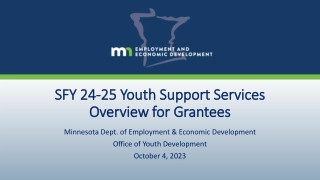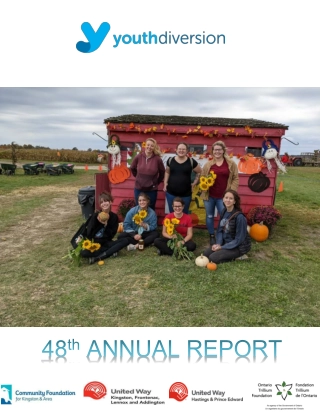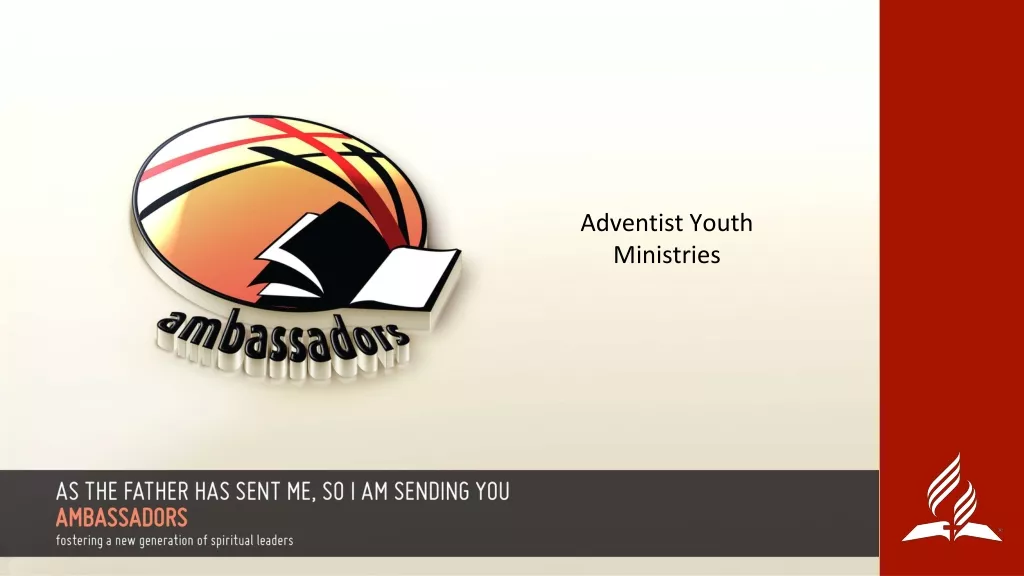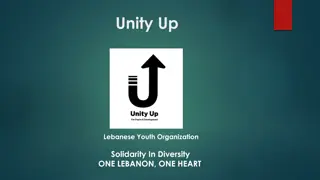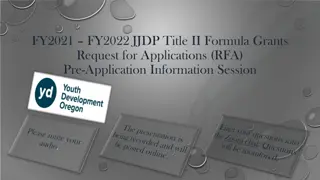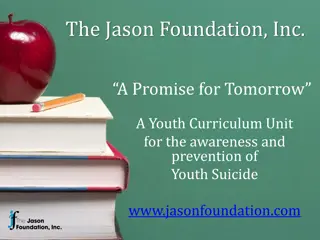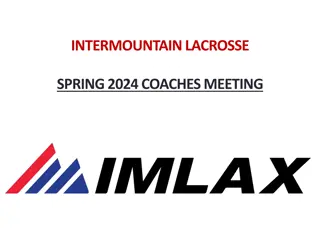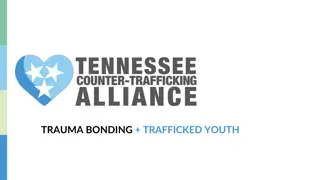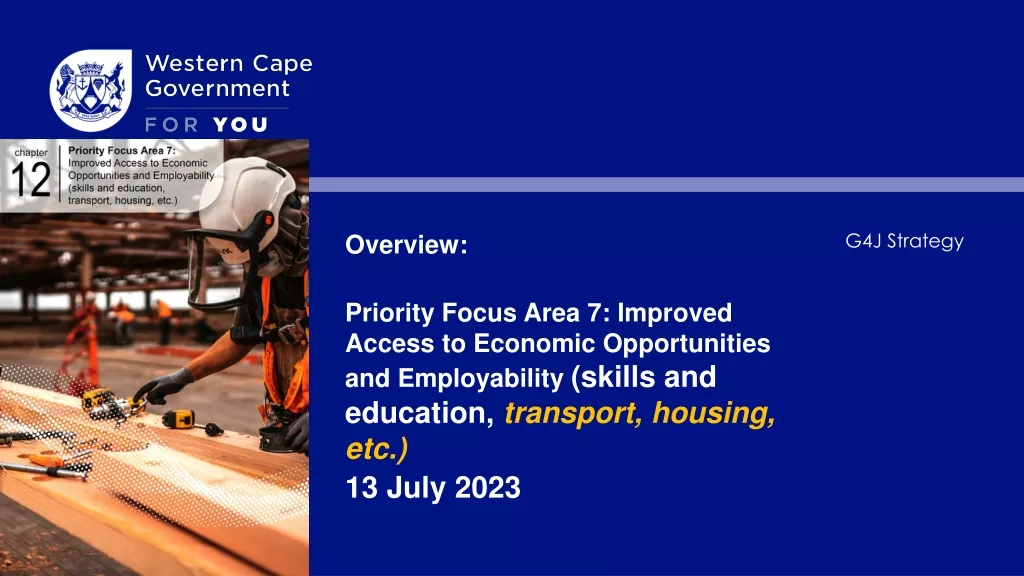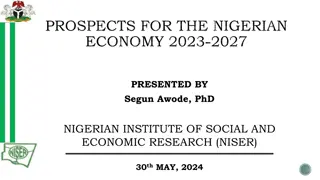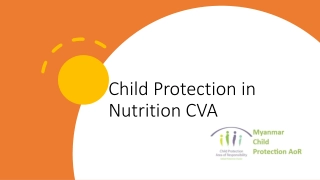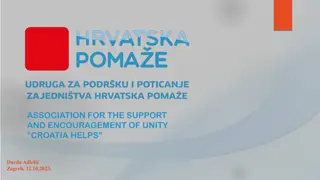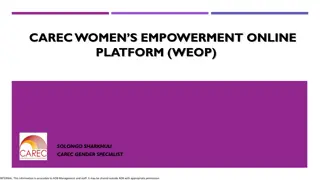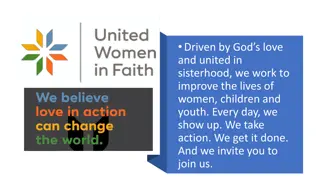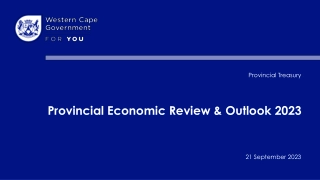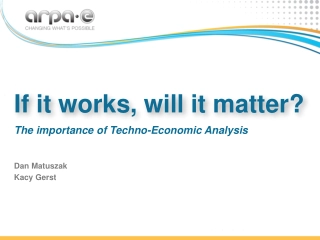Youth Economic Empowerment Palestine
Join our online information session to learn about our call for proposal for upskilling and vocational reskilling pathways in Palestine. Enhance young women and men's employability and economic empowerment.
Download Presentation
Please find below an Image/Link to download the presentation.
The content on the website is provided AS IS for your information and personal use only. It may not be sold, licensed, or shared on other websites without obtaining consent from the author. Download presentation by click this link. If you encounter any issues during the download, it is possible that the publisher has removed the file from their server.
Presentation Transcript
Youth Economic Empowerment Palestine Call for proposal for upskilling and vocational reskilling pathways in Palestine Online information session 16.05.2023 Reference: PSE21002-10012
Agenda Introduction Background: Youth Economic Empowerment Palestine Call for proposals Objectives and Expected results Budget Admissibility criteria Application Questions and answers The session is recorded for internal purposes
Results Overall objective Young women and men are better equipped to access inclusive and decent employment opportunities Result 1: A model First Employment Facility is developed and accessible to young women and men graduates Enhanced Palestinian young people's employability and economic empowerment Specific objective Result 2: Young women and men are equipped with demand-driven, quality skills Result 3: Vulnerable young women and men are supported to develop micro- or small businesses that are relevant to their local economies
Objectives and expected results for this Call
General objective General Objective Young women and men are better equipped to access inclusive and decent employment opportunities. Specific objective Young women and men are equipped with demand-driven, quality skills
The results will be measured by at least these indicators: Number of unemployed graduates and employed youth having participated in up- or reskilling for TVET through a work-based learning approach (of which at least 40% women). Please note that based on the minimum and maximum accepted grant request under this call for proposals, the minimum accepted grant request is 70,000 euro with the target of at least 100 youth, while the maximum is 90,000 euro with the target of at least 129 youth. The applicant can choose to address only upskilling or only reskilling or combine both under the target that matches their requested budget, but the costing must be logical. Number of curricula upgraded (or developed, in case it is needed to develop new ones), integrating and applying the Complex-Task-Approach principles, and accredited by the MoL, when relevant (at least two curricula shall a be achieved by each successful applicant) Number of trainers trained on upgraded (or new) curricula (at least three trainers shall be targeted by each applicant based on the targeted fields).
The results will be measured by at least these indicators: The percentage of beneficiary youth absorbed in the labour market six months after completing a training programme (at least 80%). A tracer study will be conducted by Enabel to measure this indicator. The percentage of beneficiary youth participating in the up- and reskilling training programmes obtain a recognized certificate (at least 90%). Satisfaction of the stakeholders (at least 80%). You are expected to consider more qualitative indicators to measure qualitative aspects such as knowledge increment, perception of decent work principles, occupation health skills/ capacities enhancement.
Additionally, In addition, under this call, it is expected that: knowledge on decent work, inclusion and environmental considerations of private sector companies in the targeted sectors of selected private sector companies is increased, as well as included in the developed/ upgraded curricula and in the Training of Trainers program. This training is essential for all targeted youth. Occupational Health and Safety training is delivered to youth if needed, depending on the proposed sector. All beneficiaries shall be introduced to the 21st Century Skills in cooperation with Enabel supported innovation hubs. Topics and number of hours shall be determined based on the target group's background and need. (around 10 hours maybe!)
Annex C / Logical framework It is mandatory to complete the Annex C and ensure that it is aligned with the call requirements and the expected results. Additional requirements/ tools will be introduced to the awarded applicant at a later stage. Please ensure that MEAL activities are reflected in the budget as well. Please ensure that a qualified personnel is assigned (full or part time) to carry out the MEAL activities. Results chain Indicator Baseline Target SoVs Assumptions Impact (Overall objective ) Outcome (s) (Specific objective(s)) Intermediate outcomes Outputs
Up-skilling and re-skilling In this project, continuous learning opportunities will be supported to enhance the employability potential of unemployed graduates of vocational training and higher education institutions, and to improve the potential of employed youth as well. Short-term specialized TVET courses adapted to the labour market needs will create new technical/vocational upskilling and reskilling pathways, allowing youth graduates and workers to acquire specific, new or complementary technical competencies and transversal skills, which ultimately increase their career opportunities. Under this call, Upskilling targets employees that are already working in a similar field, but through upskilling they want to increase the sustainability of their employment and/or improve their career options. Reskilling targets unemployed (or employed) youth (including those graduated from higher education and TVET institutions) in changing career tracks by broadening their current skills-set with a new skills-set.
Work-Based Learning Approach Is a set of instructional strategies that engages employers and training institutes in providing learning experiences for students. The purposes of WBL are to provide an opportunity for students to practice their learnt skills in the workplace, build student awareness of potential careers, facilitate student exploration of career opportunities, and begin student preparation for careers. WBL should be integrated with classroom learning to help students draw connections between coursework and future careers. During the implementation, it is expected that the technical training at VTC is interlaced with practical training (WBL) at the employer s site. Gradually, the number of VTC training hours decreases while the number of practical training (WBL) increases For the re-skilling targeted youth, we expect no less than 30% of the total hours to be as WBL inside the workplace. For the upskilling youth, as they are already employed so a different strategy may be proposed.
Target Group Vulnerable youth between the age of 18 and 29 years old Focus on vulnerability (50%) At least 40% of the beneficiaries should be female Provide attention for inclusion of people with disabilities in the proposal and in the training facilities As this is a reskilling and upskilling training program; participants are expected to have a clear interest and potential relevant and realistic to the training and economic sector that they will join. Reskilling Reskilling actions should target unemployed (or employed) youth (including those graduated from higher education and TVET institutions) in changing careers tracks by broadening their current skills-set with a new skills-set. Upskilling Upskilling actions should target employed youth who want to improve their employment quality and security by reinforcing their current skills.
Vulnerable youth Vulnerable youth are those who face additional barriers to employment or are usually not sufficiently equipped to benefit from job placement programmes or entrepreneurship programmes. While the final selection criteria will be further finetuned by the implementing partners and Enabel during the inception period of the implementation of each of the respective project through developing a targeting strategy for selected the beneficiaries, The following selection criteria for beneficiaries are proposed to be considered as guiding: Age and family size and structure (women breadwinners) and number of dependents Geographical location Economic vulnerability and poverty levels
Guiding Principles - Employability Employability: Expand the opportunities for people to find productive work and earn a decent livelihood - Demand driven training Demand driven training: Applicants should showcase their own analysis of labour market needs, with the private sector in the driver s seat. This should include a clear overview of relevant vacancies in the private sector, the skills needed to fill those vacancies and the skills needed to improve private sector productivity. - Partnership Partnership: A preliminary list of private sector companies who will host trainees should be identified in the proposal document with a clear description of their roles and responsibilities in the training provision process - Social inclusion: Social inclusion: address the vulnerabilities and contingencies which take people out of work (from unemployment, loss of livelihood, sickness or old age) - Standards and rights at work Standards and rights at work: incorporate standards such as the elimination of forced labour, the abolition of child labour and the elimination of discrimination in employment - Social dialogue: Social dialogue: participation and freedom of association, and as a means of conflict resolution, social equity and effective policy implementation
Duration The action may not be less than 8 months or exceed 10 months.
The actor/ applicant To be admissible for grants, the applicant must satisfy the following conditions: a) be a legal person; and b) be a local non-profit private entity or a foundation; and c) be a Private Sector Umbrella Organization (PSUO); and d) be established in Palestine; and e) be directly responsible for the preparation and management of the action with the co-applicant(s) and not be acting as an intermediary; and f) must have an active bank account for the past 24 months; and g) must have audited financial statements (income statement and balance sheet) of the last two closed financial years The applicant must act with at least and only one co-applicant
The co-applicant The call for proposal must be submitted by two actors: one lead applicant who applies together with one selected training provider as co-applicant. The proposal can target only one geographical The co-applicant shall participate in specifying the implementation of the action, and the costs that they incur shall be eligible in the same way as those incurred by the applicant. The co-applicant must satisfy the admissibility criteria which apply to the applicant itself. However, instead of the categories cited under applicants (c), (f), (g) , they must also belong to the following categories: A) be a legal person; and b) be a local non-profit private entity or a foundation; and d) be established in Palestine; and e) be directly responsible for the preparation and management of the action with the co-applicant(s) and not be acting as an intermediary; and h) The co-applicant must be a TVET provider, accredited by the Ministry of Labour The TVET provider can be a Vocational Training Centre (VTC) or non-profit training providers or NGO that has a TVET center accredited by the MoL. Please ensure to attach the accreditation of the MoL. The co-applicant must sign the declaration in part B, section 2.6 of the grant application file.
Number of requests and Grant Agreements per applicant The lead applicant may not submit an application targeting multiple regions under this Call for proposals The lead applicant may not submit more than one application under this Call for Proposals The lead applicant may not be awarded more than one Grant Agreement under this Call for proposals The lead applicant may not be at the same time a co-applicant in another application A co-applicant may be co-applicant in more than one application under this Call for proposals A co-applicant may be awarded more than one Grant Agreement(s) per geographical area under this Call for Proposals.
Type of activities Outreach and awareness activities: The applicant and its partnering VTC shall mobilise targeted unemployed and employed youth to participate in the training opportunities through outreach and awareness. Curricula development or upgrading, and Training of Trainers on the curricula, need to be budgeted by the grantees if needed. Assessment, certification and accreditation: As the accreditation of training programmes of this nature fall under the responsibility of the MoL, the MoL TVET Directorate or equivalent should be mobilized to provide licensing, if relevant and possible for the training involved. Implementationof short-termTVET up- and reskilling training programmes The training programme for all selected participants should start with the 21st Century Skills training. This training must be delivered for selected beneficiaries/ youth in cooperation with Enabel supported innovation hubs (Annex U) Selected youth will consequently access short-term technical training programmes of 30 to 70 hours in the technical and vocational areas identified based on labour market needs with 15-20 trainees per group. The training should be organized by those VTCs that have expertise in delivering the training content. Propose a number of graduates enrolled in the programme that is realistic and has an acceptable cost-ratio per graduate. Employed trainees (upskilling) can do their employer-based training with their own employer, if possible. Training on decent work should be included for all trainees and employers. Training on Occupational Health and Safety should be provided depending on the proposed sector.
How Ensuring competent coaches and trainers for the different types of training, coaching and follow- up - with experience in working with vulnerable groups - is essential. Specific services supporting social inclusion and equitable access (i.e. services responding to specific needs of vulnerable graduates such as additional transportation arrangements, flexible working hours, day care services for young mothers, specialized counselling or psychosocial support preventing/mitigating the risk of drop-out, community sensitization, accessibility ). Ensuring a meaningful participation of the private sector in all stages (identification, design, implementation and assessment) of the training programme. Provision of insurance against accidents and work-related injuries for graduates and on-the-job trainers and coaches, provision of protective wear, Occupational Health and Safety trainings, knowledge of decent work concept, equipment and other measures adhering to the national standards. Regular overarching monitoring of the quality and progress of the different parts of the training programmes, as well as of the satisfaction of the trainees, employers and other stakeholders. Develop evaluation tools and plan to support this process. Demonstrate the capacity of the PSUO (and VTC) to manage the up- and/or re-skilling trainings (from selection to preparation, matching and actual implementation and coaching)
And, Integrate new technology and/or innovations within different fields, if relevant and possible. Include digitization aspects if applicable. We highly encourage targeting focused digital skills such as graphic design, quality assurance, facility planning, warehouse management among others that would enhance the performance of the private sector. Prioritize environmental jobs or green jobs if promising in the sector. Detail the relevant and fair selection of graduates (targeting strategy) while ensuring meeting the vulnerability and age range Please refer to section 2.1.3 Admissible actions: for what actions may an application be submitted? of the applicants guideline and Annex L
Budget 386,500 EUR East Jerusalem (20%) Gaza (40%) West-Bank (40%) All proposals should be between 70.000 Euro and 90.000 Euro * The percentage distribution is indicative and subject to final assessment * An application (one proposal) cannot target more than 1 region
The costs Operational costs are the necessary and indispensable costs for achieving the objectives and results of the action; Management costs are identifiable costs related to management, supervision, coordination, monitoring, control, evaluation and financial audit which specifically originate in the implementation of the action or the justification of the Grant; Structure costs are costs related to the achievement of the social purpose of the beneficiary, which even though they are influenced by the implementation of the action are neither identifiable or attributable to the budget of this action. Max 7% of operational cost.
It is mandatory to complete Annex B, the budget and the detailed sheet where all budget lines need to be clearly illustrated. The budget should be prepared as (Result, Activity, and then Action or Sub activity). Alignment and consistency between the proposed activities and budget is a must. Any major errors or inconsistencies in the proposal (inconsistency of amounts included in the budget calculation sheets, for example) may lead to immediate rejection of the proposal. Propose a number of graduates enrolled in the programme that is realistic and has an acceptable cost-ratio per graduate; the expectedmaximumcost per beneficiaryis 700 Euro from the total budget As the co-applicant must be an accredited provider by the MoL, the training shall be paid in accordance with the relevant law, e.i. if the trainer is an employee of the center, a percentage of his/ her salary will be covered based on the numberof training hours. Trainers /Experts are not eligible to receive duplicate payments of salaries from Enabel grants. They are eligible to receive their salaries as per their contracts, while Enabel can cover part of the salary as per the time sheet (% of time allocated to conduct trainings). If the trainer works on the activities overtime, the basis of calculating the hourly rate is the governmental laws for TVET Centers or based on specific regulationapprovedand authorized by the Co-applicant s manual and policies. Therefore, for allowance and over-time payments: Reference rules and regulations (from co-applicant) and calculation tables are required. The percentage of the management cost distributed among the budget and the structure cost shouldn t be more than 30% of the total requested fund .
Evaluation of applications Step 1: Proposals satisfying the conditions of the administrative and admissibility check will be evaluated. Step 2: As part of the assessment process, Enabel will then conduct an institutional organizational analysis of the applicants included in the provisional allocation table in order to confirm that these applicants have the required capacities to complete the action If any of the information is missing or incomplete, the application may be rejected on this sole basis and it will not be evaluated The organization assessment will be following proposal selection and prior to contracting. In order to ensure the equal treatment of applicants, the contracting authority cannot give a prior opinion on the admissibility of applicants, an action or specific activities
Deadline for clarification requests 12/05/2023 (3pm) Online information session Launching 16/05/2023 Evaluation & organization assessment Proposal Submission deadline Clarifications by the contracting authority 18/05/2023 (3pm) Second half of June 2023 7/06/2023 (3 pm) Notification of the Award Decision July 2023 Provisional dates
Remember, Read the guidelines thoroughly and its annexes Follow the submission guidelines (be on time, complete the Annex A and sign it, co-applicant declaration, etc.) An electronic version of the proposal must also be provided. A USB - not CD - containing this document and annexes will be placed, with the paper version, in a sealed envelope. The electronic file must be exactly the same as the attached paper version. The outer envelope must bear the reference number and the title of the call for proposals (Reference: PSE21002-10012) Provide all required annexes including the ones related to exclusion ground Ensure that you meet the budget and duration boundaries of the call To complete Annex B (the budget and its description sheet), Annex C (the logframe with all required details to meet the requirements of the call) To add, a preliminary list of private sector companies who will host trainees with a clear description of their roles and responsibilities in the training provision process Applicants should showcase their own analysis of labour market needs, with the private sector in the driver s seat
Annexes The following annexes must be attached to the proposal: 1. The statutes or articles of association of the applicant and any co-applicants 2. A copy of the applicant's most recent financial statements (income statement and balance sheet for the last two closed financial year). Any co-applicants are not required to submit a copy of their financial statements. 3. The legal entity sheet (see Annex D of these guidelines) duly completed and signed by each of the applicants (ie the applicant and each of the possible co-applicants), accompanied by the supporting documents requested.
Annexes for the exclusion situations Document 1: Public Law Legal Entity Form or Private Company Legal Entity Form Document 2: Financial Identification Form Document 3: Registration Certificate (applicant and co-applicant) Document 4: Deduction at source Certificate (applicant and co-applicant) Document 5: Active bank account for the past 24 months Document 6: Audited financial statements (income statement and balance sheet) of the last two closed financial years Document 7: Declaration from a competent authority of not being in a situation of bankruptcy or insolvency. Document 8: Non-sentence Certificate from the Ministry of Justice (for board members). Document 9: The Ministry of Interior registration of the Board. Document 10: Declaration on Honour form (signed and stamped by applicant and co- applicant). Document 11: The Integrity statement form (signed and stamped by applicant and co- applicant).
Additional supporting annexes A brief communication plan that covers the proposed communication activities. Please ensure accommodating your plan about how you will utilize communication to contribute to achieving your end objective. The curricula of the up-and reskilling targeted fields must be attached if available. HR recruitment process for the proposed staff, and CVs of available staff members must be attached A fair selection of youth (targeting strategy) while ensuring meeting the vulnerability and age range shall be shared in the proposal A preliminary list of private sector companies who will host trainees should be identified in the proposal document. The strength of the partnership and level of cooperation between partners will be evaluated and will contribute to decision making on successful applications. A needs analysis/ assessment of labour market needs and relevant skills needed to demonstrate the relevancy of the proposed programme/ training. For allowance and over-time payments: Reference rules and regulations and calculation tables are required.



